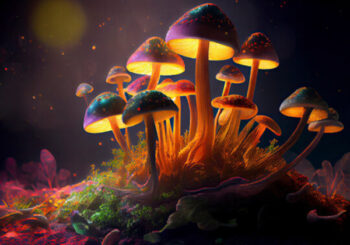By John Patterson
Staff Writer for Wake Up World
In the lush tapestry of nature, the Psilocybe fungi, affectionately known as “magic mushrooms,” have woven threads of mystery and significance for centuries in Indigenous cultures of Mesoamerica. While these psychedelic organisms gained notoriety during the counterculture movements of the 60s and 70s, they are now emerging as pioneers in a mental health revolution. Psilocybin and psilocin, the enchanting compounds found in these fungi, are revealing their potential as therapeutic agents for conditions like PTSD, depression, and end-of-life care.
[pro_ad_display_adzone id=”110028″]
Unraveling the Genetic Tapestry
To unlock the therapeutic potential of psilocybin, scientists require a comprehensive roadmap of the compound’s underlying genetics and evolution. Until now, our knowledge has been limited, with research focusing on only a fraction of the approximately 165 known species of Psilocybe. However, a groundbreaking study led by the University of Utah and the Natural History Museum of Utah (NHMU) has delved into the genomic diversity of Psilocybe like never before.
In their quest, the researchers analyzed 52 Psilocybe specimens, including 39 species never before sequenced. Their findings, published in the Proceedings of the National Academy of Sciences on January 9, 2024, challenge preconceptions about the timeline and evolution of Psilocybe.
A Trip Through Time
Contrary to previous beliefs, the study reveals that Psilocybe has ancient roots, dating back approximately 65 million years ago. This research unveils the intricate dance of psilocybin synthesis, indicating four to five possible horizontal gene transfers to other mushrooms between 40 and 9 million years ago.
The analysis uncovers two distinct gene orders within the psilocybin-producing gene cluster, suggesting an ancient split in the genus Psilocybe. This revelation points to two independent acquisitions of psilocybin throughout evolutionary history, offering a compelling insight into the complex web of genetic sequences governing the synthesis of psychoactive compounds.
Psilocybin’s Evolutionary Purpose
Amidst the genomic revelations, the researchers seek to answer a fundamental question: What purpose does psilocybin serve for mushrooms? The molecular structure of psilocybin mimics serotonin, binding tightly to serotonin receptors, inducing altered behaviors in mammals, insects, and arachnids. Some propose that this altered mental state acts as a deterrent to predation or as a defense against insects.
One intriguing theory, the Gastropod Hypothesis, posits that psilocybin evolved as a deterrent against terrestrial slugs. The timing of Psilocybe’s divergence coincides with the asteroid impact that led to a brutal, prolonged winter, favoring fungi and terrestrial gastropods. The researchers are conducting feeding experiments to explore this hypothesis further.
[pro_ad_display_adzone id=”110030″]
Health Benefits of Psilocybin
Beyond the evolutionary intricacies, the study raises the tantalizing prospect of psilocybin as a “wonder drug” with potential therapeutic applications. Bryn Dentinger, curator of mycology at NHMU, envisions the importance of utilizing biodiversity to enhance the efficacy of psilocybin therapeutics. He states, “If psilocybin does turn out to be this kind of wonder drug, there’s going to be a need to develop therapeutics to improve its efficacy. What if it already exists in nature?”
The potential mental health benefits of psilocybin are supported by its serotonin-mimicking properties, which could contribute to alleviating conditions such as PTSD and depression. As research advances, the prospect of incorporating natural compounds for mental health interventions becomes increasingly promising.
Unlocking Nature’s Secrets
In the pursuit of understanding Psilocybe’s genetic code, the researchers leveraged DNA from specimens in museum collections worldwide. Their meticulous work on type specimens, the gold standard in taxonomy, establishes an authoritative foundation for future studies on Psilocybe diversity. Alexander Bradshaw, lead author of the study, emphasizes the significance of this molecular and genomic data, stating, “That’s the beauty of it — no one has really sequenced type specimens at this scale, and now we get to produce molecular and genomic data to the gold standard of Psilocybe types for people to compare against.”
As the journey through time and genes unfolds, the revelations surrounding Psilocybe fungi not only deepen our understanding of their evolutionary history but also open doors to potential breakthroughs in mental health treatment. The magic of these mushrooms extends beyond psychedelic experiences, beckoning us to explore the untapped mysteries of the natural world for the betterment of human well-being.
Recommended reading
-
Psilocybin Mushrooms of the World: An Identification Guide by Paul Stamets – comprehensive guide for identifying psilocybin mushrooms globally, authored by renowned mycologist Paul Stamets.
- The Psilocybin Mushroom Bible: The Definitive Guide to Growing and Using Magic Mushrooms by K. Mandrake – A practical guide covering the cultivation, identification, and use of psilocybin mushrooms, providing insights for both beginners and experienced enthusiasts.
- Magic Mushroom Explorer: Psilocybin and the Awakening Earth by Simon G. Powell – An exploration of the historical, cultural, and spiritual aspects of magic mushrooms, delving into their potential impact on human consciousness and societal evolution.
- Psilocybin: Magic Mushroom Grower’s Guide: A Handbook for Psilocybin Enthusiasts by O.T. Oss and O.N. Oeric – A classic guide that provides detailed instructions on cultivating psilocybin mushrooms, written by the McKenna brothers under pseudonyms.
-
The Psilocybin Solution: The Role of Sacred Mushrooms in the Quest for Meaning by Simon G. Powell – Simon G. Powell examines the historical, cultural, and spiritual dimensions of psilocybin mushrooms, exploring their potential significance in the pursuit of meaning and understanding.
Reference:
- Alexander J. Bradshaw, Virginia Ramírez-Cruz, Ali R. Awan, Giuliana Furci, Laura Guzmán-Dávalos, Bryn T. M. Dentinger. Phylogenomics of the psychoactive mushroom genus Psilocybe and evolution of the psilocybin biosynthetic gene cluster. Proceedings of the National Academy of Sciences, 2024; 121 (3) DOI: 10.1073/pnas.2311245121
About the author:
John Patterson is an avid writer and researcher who delves into the latest scientific research. With an insatiable curiosity, he translates complex concepts into accessible narratives, allowing readers to embark on a journey of discovery. Through his work, John bridges the gap between experts and the public, igniting curiosity and inspiring meaningful conversations about scientific breakthroughs.
[pro_ad_display_adzone id=”110027″]







